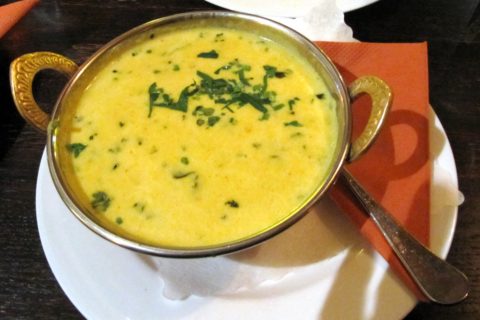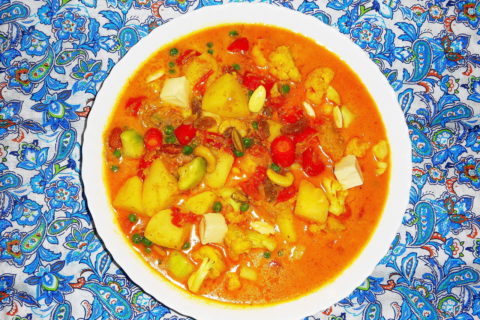As any traveler to Britain knows, Indian cuisine has had a huge impact on the British table. Curry dishes are even often standard fare in that most quintessentially British institution the pub.
The below recipes are printed with permission from Jennifer Brennan’s book, Curries and Bugles.
The British Raj refers to the period of the British colonial regime on the Indian subcontinent from 1858 to 1947. The Raj began in 1858 with the transfer of the possessions of the East India Company to Queen Victoria, who was proclaimed Empress of India in 1876. It extended mainly over the territories that today make up India, Pakistan and Bangladesh, as well as Burma until 1937.
As the British gradually took control of India, they quickly developed an Anglo-Indian way of life, as English and Indian culture gradually merged – customs, clothing, language and especially food. Anglo-Indian cuisine made its debut. This type of cuisine emerged when British wives interacted with their Indian cooks. They brought an English touch to Indian products. Here are 3 recipes from the British Raj’s Anglo-Indian cuisine:
Kedgeree of smoked haddock

Haddock Kedgeree photographed for the National Trust Spring Cookbook.
Kedgeree derived from a traditional Indian dish originally called Khichri, which is mainly composed of boiled rice, pieces of fish and hard-boiled eggs. It was introduced in England as a breakfast dish by the returning British colonials. It is a prime example of Anglo-Indian cuisine.
Serves 4
Ingredients
- ½ lb. smoked haddock
- 4 tablespoons/2 oz. unsalted butter
- 1 lb./2 ⅓ cups cooked long-grain rice
- 2 hard-boiled eggs, shelled and chopped
- 3 springs of parsley, finely chopped
- 1 pinch of nutmeg
- ½ teaspoon salt
- ¼ teaspoon ground white pepper
- 1 tablespoon herb vinegar
Method
- Poach the haddock in a little water until the fish flakes easily with a fork.
- Drain, remove any skin and bones and flake the flesh into a bowl.
- Melt the butter in a medium pan over moderate heat and sauté the rice until it is warmed through. Add it to the haddock.
- Add all the remaining ingredients, stirring lightly to combine everything.
- Turn the kedgeree out on a heated platter. The kedgeree may be kept in a low oven for 5-10 minutes before serving.
Notes: Kippers or any other smoked fish may be substituted for the haddock. The kedgeree can also be surrounded by a ring of thickly cut, lightly grilled slices of tomato.
Mulligatawny Soup
Mulligatawny Soup comes from South Indian cuisine. It got its name from the Tamil words molagu, meaning pepper, and tunni, meaning water. This “pepper water” was adopted by the poor, who added some salty dried fish to make it more substantial. Later, the British Raj appropriated it after that the Anglo-Indian used to eat it with some chicken. Try this very popular dish from the time of the Raj.
Serves 6

Mulligatawny Soup
Ingredients
- 2 cloves of garlic, smashed, peeled and finely chopped
- 1-inch piece of fresh ginger root, peeled and finely chopped
- 1 teaspoon cayenne
- 1 teaspoon ground turmeric
- 1 teaspoon ground coriander
- 1 teaspoon ground cumin
- 1 bay leaf, broken into fragments
- 1 tablespoon vegetable oil
- 2 tablespoons ghee (clarified butter)
- 1 large onion, peeled and finely chopped
- Meat from 4 bones and skinned chicken thighs, diced, with the bones reserved
- 6 fl oz. coconut milk
- 1 quart chicken stock
- 6 tablespoons lentils (toor, arhad or masoor dhal)
- 1 teaspoon tamarind concentrate or 2 tablespoons tamarind pulp, dissolved in 4 tablespoons boiling water, strained
- 3 tablespoons rice
- ½ teaspoon garam masala (sweet spice mix)
- Coriander leaves for garnish
Method
- Place the first 8 ingredients, including the vegetable oil, in a food processor or grinder and process or grind into a paste.
- Place the ghee in a large saucepan and fry the onion, stirring, over moderate heat until it is golden, then add the spice purée from the processor and continue to fry and stir for 3 minutes, until the spices are well cooked and mellowed.
- Add the chicken meat and the bones and stir for 1 more minute. Then pour in the coconut milk and let the mixture simmer, uncovered, for 5 minutes.
- Pour in the chicken stock and add the dhal; stir and cover the pan. Bring barely to a boil, reduce the heat and let the soup simmer for 30 minutes, or until the dhal has totally disintegrated and the onion is soft enough to squash against the side of the pan. Fifteen minutes before the end of the cooking, add the rice.
- Strain out the meat and rice on to a plate and discard the bones. Purée the soup in batches in batches in a blender and then return it to the pan over heat. Stir in the tamarind until it has dissolved, bring the soup just to the point of boiling again.
- Turn off the heat and pour the soup into a tureen or into individual soup bowls. Sprinkle with garam masala and garnish with coriander leaves.
Notes: There are as many ways to make this soup as there are people to eat it. Lamb stock can be substituted for chicken, or the soup may be made entirely in vegetarian style by using water as the cooking liquid, omitting the meat and, perhaps, frying a few almonds and peanuts in the spice paste instead. Additional onions can be crisp-fried in butter and used for garnish. The soup may also be enriched by chopped celery, carrots and tomato purée being added with the stock.
Tamarind is available in various forms from Asian food stores.
Madras Club Quoorma (Korma)
Korma originated in the lavish Mogul cuisine wherein meat or vegetables were braised in velvety and spiced sauces, with ground nuts, cream and butter. It traveled from the kitchens of the conquering Mogul emperors to the ones of the renowned Madras Club, where it was referred to by the British as quoorma. Enjoy it with a fragrant rice pilaf.
Serves 6

Navratan Korma
Ingredients
- 3 lb lean, boneless lamb, cut from the leg
- 1½- inch piece of fresh ginger root, peeled and finely chopped
- 1½ teaspoons salt
- 10 tablespoons/ 5 oz. unsalted butter
- 3 large onions, peeled and sliced into rings
- 3 cloves of garlic, smashed, peeled and finely chopped
- 1½ teaspoons coriander seeds
- 1½ teaspoons black peppercorns
- 6 whole cardamom pods
- 6 whole cloves
- 6 oz./ 1 cup ground almonds
- 6 fl oz. cream
- 2 teaspoons ground turmeric
- 1½ teaspoons sugar
- Juice of 2 small limes
Method
- Cut the lamb into 1½-inch cubes and pat them dry with paper towels. Place them in a large mixing bowl with the ginger and salt and toss well.
- Melt the butter in a large non-stick saucepan and put in the onions and garlic. Fry them slowly over low heat, stirring occasionally to prevent the garlic from sticking to the bottom of the pan, until the onions are limp and very soft.
- While the onions and garlic are frying, place the coriander seeds, peppercorns, cardamom pods and cloves in a spice grinder or mortar and grind or pound them to a fine powder. Stir the spice powder into the onion mixture and cook it, stirring, for 5 minutes.
- Turn the heat up to moderate and add the lamb mixture from Step 1, scraping in all the ginger and salt remaining in the bowl. Fry the meat, stirring and turning it until it is nicely browned. Remove the pan from the fire.
- Place the almonds in a 1-quart measuring jug or heat-proof bowl and pour in ¼ cup of boiling water, stirring to bring out the essential oil and its aroma. Work in the cream, turmeric and sugar.
- Replace the saucepan on the heat and wait until the oil begins to sizzle again; then stir in the almond cream mixture. Turn the heat as low as possible and stir the lamb well until it is coated with the sauce. Let the meat simmer for about 30 minutes, stirring from time to time to prevent it sticking. The rich gravy should reduce to the consistency of thick cream and should thoroughly coat the lamb (the length of time that the quoorma takes to reach this stage will depend on the diameter and depth of your pan and the amount of moisture in the lamb, so there will be variations in the cooking period.)
- Transfer the quoorma to a serving dish and sprinkle it with lime juice. The dish may be kept warm in a low oven for a short while before serving, but do not let the gravy dry out.
Notes: If you use lamb in the recipe, you can use filet and 1 lb neck for bones which makes it richer. The proportion is about 1 lb of bones to 3 lb of meat. After the meat bones have given off their taste, they are of course removed prior to serving.



